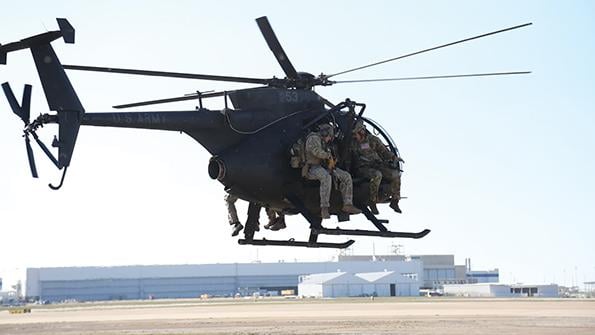
A long future may still be ahead for the Boeing A/MH-6 Little Bird fleet—unless the days are numbered for the longest-serving helicopter in the U.S. Special Operations Command fleet.
With the first newly upgraded Block III versions of the attack-and-assault aircraft set to enter service later this year with the 160th Special Operations Aviation Regiment, the long-term fate of the 51-aircraft fleet hinges on the U.S. Army’s choice for the Future Attack Reconnaissance Aircraft (FARA).
The Army’s conventional forces need the FARA program to replace the long-retired Bell OH-58D Kiowa Warrior helicopter, along with the subset of the Boeing AH-64 fleet now performing the armed scout mission on an interim basis.
But the Special Operations Forces need the FARA program to replace the A/MH-6, and therein lies the problem. The Army is considering two candidates—the Sikorsky Raider X and the Bell 360 Invictus—for the FARA contract. As now configured, only one of the designs—the Raider X—meets 160th’s future requirement for an aircraft that can carry a squad of assault troops internally. Like all other attack helicopters except the Raider and the Mil Mi-24 Hind, the 360 Invictus lacks a passenger cabin.
“We want to be able to carry four passengers per threshold and six passengers for an objective,” Geoff Downer, the command’s program executive officer for rotary wing, said at the virtual Special Operations Forces Industry Conference on May 19.
If the Army selects the 360 Invictus, Special Operations Command will have to make a decision: Further upgrade the A/MH-6, or acquire and modify a different commercial helicopter, Downer said.
“We don’t know which platform the Army is going to select for Future Vertical Lift,” Downer said. “That will help inform a lot of the decisions we have going forward.”
The Army plans to award the FARA contract at the end of fiscal 2024. If the selection is the Raider X, the A/MH-6’s replacement decision may be straightforward. If not, the special operations community will take a year to weigh options and decide what to do in early fiscal 2026. Until then, “MELB-X”—Mission-Enhanced Little Bird-X—will adorn Downer’s chart showing the timeline for the A/MH-6 replacement.
“MELB-X is really just a placeholder for us to look at options going forward,” Downer said.
- A/MH-6 replacement decision set in 2026
- First A/MH-6 Block III deliveries begin this year
If FARA does not become the answer for MELB-X, one alternative is a Block IV version of the A/MH-6. But Downer acknowledged that adding a few more decades of service life and additional performance on the Little Bird airframe could be difficult, if not impossible. The A/MH-6 is derived from the Hughes Tool Company’s Aircraft Division Model 369, which first flew in 1963. Four years later, the Army acquired the Model 360 as the OH-6 Cayuse.
In the early 1980s, the 160th inherited OH-6s that had been stored since the Vietnam War ended. Over the next four decades, Special Operations Command steadily expanded the service life, survivability and performance of the single-engine light helicopter. The Block II MELB version entered service in 2004, with six blades instead of five, four tail rotor blades instead of two and a 4,700-lb. maximum gross takeoff weight instead of 3,500 lb. The Block II version also added crashworthy fuel systems and seats for the first time.
“Over the 40 years we’ve had the aircraft, we’ve added significant capabilities, essentially doubled the gross weight, and we improved the survivability of the platform,” Downer said.
The Block III version now in production adds a new machined airframe from Boeing, resetting the structural service life of the 51-aircraft fleet to zero. The tail boom is being stiffened and extended to offset additional loads from the more powerful tail rotor. The rotation of the tail rotor blades also is changed to reduce interaction with downwash from the main rotor, which improves fuel efficiency.
The six-blade main rotor itself also becomes significantly more powerful in Block III. Boeing expands the 27.4-ft. rotor diameter of the Block II version by more than 1 ft., to 28.5 ft. The new version also replaces the six metal blades with composite structures, each of which features advanced symmetric airfoils. The cockpit also is replaced with three new multifunction displays and a new mission processor.
Those upgrades keep the A/MH-6 fleet relevant for another decade, but may leave little room for continued improvement.
“The question is how much more—we’ve already gone from four blades to six—so how much more can we add,” Downer said. “The key thing is in going to the [MELB-X] we [currently] can’t fly anywhere near the speeds that Future Vertical Lift is projected to fly, and that’s going to be critical for us on the battlefield in the future.”






Comments